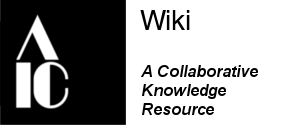Crayon Portraits, Solar Enlargements and Painted Photographs
Back to PMG Photographic Processes
| Page Information | |
| Date initiated | May 2024 |
| Contributors | Luisa Casella |
Please note: This page specifically addresses crayon enlargements. It does not include daguerreotypes, tintypes, or other photographic processes with applied color or retouching.
Painted Photographs[edit | edit source]
Historical Facts[edit | edit source]
Crayon portraits or solar enlargements became popular from the mid-19th century, the solar enlarger being introduced in 1857 by David Acheson Woodward. They are silver-based photographic enlargements on paper support, enhanced or wholly overpainted with a range of media, including pastels, watercolors or oil paints. They offered an affordable alternative to painted portraiture and were typically sold by studios or mail-order companies. They are often mistaken for drawings or paintings.
See also PMG Treatment of Enlargements with Applied Media (Crayon Portraits) Page
Identification Characteristics[edit | edit source]
Image material[edit | edit source]
Silver based photographic enlargement (salted paper, albumen, silver gelatin), and varying applied media (Chalk, pastel, graphite, watercolor, oil paint, synthetic dyes).
Color[edit | edit source]
Monochrome photographic base. Monochrome or full color final image, depending on applied (dry and wet) media. The color application may range from subtle tinting to full coverage of the photographic base.
Support[edit | edit source]
Most commonly paper, canvas (often as a secondary support), or composite boards. Some works are flat-mounted, others are shaped into convex forms, others are stretcher on a strainer. Surface preparations such as pumice abrasion or coating with gum arabic or gelatin were common to provide a "tooth" for the media.
Other names:[edit | edit source]
Solar photograph, solar portrait, solar enlargement, solars, enlargement, chromatypes, pastel photograph, crayon enlargement, crayo-type, photo-crayon, photo-crayotype, crayon collotype, crayon print.
Conservation[edit | edit source]
Common conservation issues include tears, planar distortion, brittle supports, severe grime (as these were often framed without glazing), support discoloration, flaking media. losses.
Treatment approaches may involve consolidation of friable media, surface cleaning, washing, lining, tear mending, humidification for flattening, and inpainting. See also PMG Treatment of Enlargements with Applied Media (Crayon Portraits) Page.
Housing and Storage Considerations[edit | edit source]
Housing[edit | edit source]
Most commonly these are meant to be displayed so should be housed in sealed packages with a spacer or windowmat to separate from the glazing.
Storage[edit | edit source]
Maintain at general levels recommended for paper based photographs. Store horizontally in flat files or vertically with adequate support. Maintain stable environmental conditions (RH 40–50%, temp ~18–21°C). Convex formats should be custom housed and not undergo pressure.
Exhibition[edit | edit source]
Use UV glazing when possible. If using original domed glass, ensure owners are aware that it will not be UV filtering. Companies such as InLine Ovals provide custom sized domed glass and domed acrylic glazing (please not this is not an endorsement of this specific supplier and more can be added by recommendation).
As a spacer for oval frames, Glasguard can be applied along the edges of teh glass to prevent it abrading the object.
Emergency Recovery[edit | edit source]
As with other object with applied media, water damage can result in complete loss of color layer. Air dry as soon as possible, placing horizontally, not touching the image surface.
Further Reading[edit | edit source]
| Copyright 2025. Photographic Materials Group Wiki is a publication of the Photographic Materials Group of the American Institute for Conservation. It is published as a convenience for the members of thePhotographic Materials Group. Publication does not endorse nor recommend any treatments, methods, or techniques described herein. Please follow PMG Wiki guidelines for citing PMG Wiki content, keeping in mind that it is a work in progress and is frequently updated.
|
Back to Photographic Materials Main Page
Back to PMG Photographic Processes
